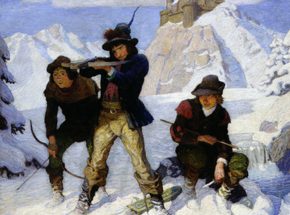

Singer, founder of the Washington County Museum of Fine Arts in Hagerstown, was born in Allegheny, on the north side of what is now Pittsburgh, Pennsylvania. His father was in the steel business of Singer & Nimick in Pittsburgh, founded by the artist’s uncle, John Singer in 1854.
Singer had early decided on a career in art. His mother, Hester Harton Singer, encouraged his artistic pursuits, while his father was a Sunday painter and his grandfather George Singer had been a painter and gilder of chairs in Greensburg, Pennsylvania. In 1895, Singer married Hagerstown resident, Anna Brugh and in the summer of 1900, they went to Monhegan Island in Maine where Singer began painting full time.
In 1901, the couple crossed the Atlantic and Singer enrolled in the Academie Julian in Paris for several months. His love for the outdoors, drove him to leave the Academie to paint directly from nature. They moved to Laren, Holland, not far from Amsterdam, where a regional school of artists flourished. The couple began spending summers on the west coast of Norway and settled near the village of Olden on the Nordfjord, north of Bergen during World War I.
Singer’s greatest artistic inspiration came from painting the Norwegian landscape. Although the first World War closed the era of painting abroad for most artists, Singer remained, painting in the style of the post-Impressionists long after it was fashionable. His work often shows the influence of Pointillism with its stippled coloration.
Glorifying the natural setting, Singer created beautiful landscapes throughout the 1920s and 1930s until his death in Norway during the Nazi occupation.
www.askart.com

